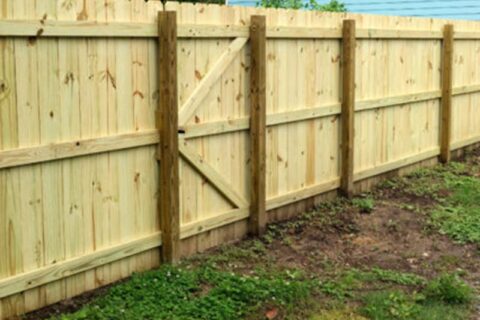A Guide on How to Waterproof a Fence
Don’t let anyone tell you to let your wooden fence weather before you paint or seal it. Weathering deteriorates wood.
Forest Products Laboratory reported that as little as three weeks of exposure to sun and rain is too much for wood.
Did you know the ultraviolet rays of the sun alter the natural glue that holds wood together? So don’t let your wooden fence stand naked against the baking sun for too long.
Read more about how to seal a wood fence, bringing out its natural beauty while protecting it from the weather.
Know Your Wood
Do you know what kind of wood was used to make your fence? Some woods are naturally durable and last longer when exposed to the elements. Here’s a list of fence wood and its durability:
- Superior durability – black locust, white oak and yew
- High durability – Western red cedar, redwood, red oak, and Western juniper
- Less durable – pine, white fir, Douglas fir, cottonwood, alder
All wooden fences need fence waterproofing. But understanding the different types of wood gives you an idea of how long you can expect your fence to last.
How Weather Exposure Ruins Your Wooden Fence
Lignin is a natural polymer inside of wood. It repels water and binds the cells together. Weathering destroys lignin and then the wood fibers loosen. When it rains, the unprotected wood sucks up the water, which causes rotting on the wood’s surface.
If you don’t apply wood fence waterproofing before decomposition starts, the wood swells. When the sun dries out the wood, the fibers shrink again. This stresses the wood’s surface, preventing good bonding with sealant or paint.
You might not see the change in the wood’s surface until after you paint. Then you’ll see peeling and cracking paint.
That’s bad enough, but when the paint peels, it takes the wood surface with it. This degrades your wood fence even more.
How to Seal a Wood Fence for Long-Lasting Beauty
Preparation and using the right products make all the difference in whether waterproofing your wooden fence will be effective. Follow these tips for fence waterproofing to extend its life.
Clean and Prepare the Wooden Fence
This is the most important step before you can apply a fence water seal or stain. The wood has to be clean for the waterproofing to penetrate and stick to the fence. You also have to make sure that the pH of the wood is correct and the pores are open.
No matter how good your waterproofing product is, it won’t adhere if the wood’s surface isn’t prepared and cleaned.
Many people try to take the quick way out and use a pressure washer to blast water and bleach on the fence. This might work, but why risk damaging the investment in your fence?
Using the right wooden cleaners are your best bet for getting off old sealers, stains, mold, and mildew. This will make your wooden fence look new again.
Strip off Any Fence Water Seal or Stain
If you waterproofed or stained your fence before, you need to strip the surface of the wood to remove them. Even if you can’t see the stain because of weathering, it’s still inside the wood’s pores. This will block the new sealer from penetrating the wood.
You can use a wood stripper to remove the old waterproofing products.
If you don’t have any previous wood fence waterproofing, you’ll begin preparation by cleaning any mold, dirt, sap and other stains from the wood. This will restore the wood’s natural color.
You can find non-toxic, safe sodium percarbonate wood cleaners at any home improvement store.
Neutralize the PH
The next step is to neutralize the pH in the wood. The cleaners you used raised the pH of the wood so you have to balance it. Apply an acidic wood brightener after you strip or clean the fence.
The wood brightener neutralizes the pH while it brightens the wood. It also allows the sealer or stain to penetrate the wood.
It’s Time to Apply Wood Fence Waterproofing
After finishing all your prep work on the fence, you can apply waterproof fence paint, sealer or stain. Check your fence before applying any sealer to make sure it’s completely dry. Look between the slats and near the ground for any moisture.
Make sure you use high-quality oil stains or sealers to protect your fence from the sun’s ultraviolet rays, humidity, rain, and heat. The color pigments in stain actually repel UV light, which prevents the wood from turning gray.
If you use clear wood fence waterproofing, the sun’s rays can still turn the wood gray. But the water sealer will protect your fence from water damage and moisture.
Some stains come with sealer in them and condition the wood to prevent your fence from warping.
Apply the stain or waterproofing with a medium-napped roller and immediately go over the surface with a brush. This spreads the product evenly, making sure it reaches between the slats and into the grain of the wood.
Be generous when you apply the penetrating oil stain or sealer. You want to saturate it so the stain goes deep into the wood and won’t wear away. This will also produce a deeper color and bring out the natural grain of the wooden fence.
For the best results, apply two heavy coats to your fence.
Maintaining Your Wooden Fence
After going through all the preparation and applying your fence water seal, it’s easy to maintain. You’ve already done the hard part.
The waterproofing or stain will give your fence years of protection from the weather and the sun. Every few years just clean your fence and apply a maintenance coat to keep it looking like new.
Enjoy the Beauty and Privacy of Your Wooden Fence
After following these tips on how to seal a wood fence, you can sit back and relax. Enjoy the natural scent and beauty of your wooden fence as you sit by the pool or barbecue on your patio.
You won’t have to worry about the wind, rain or UV rays damaging your fence for years to come.
Contact us for more information on choosing the best wooden or vinyl fencing for your Florida home.


